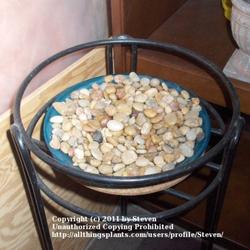It's a well known fact that too much humidity in a home can cause serious problems, with mold being the main one. We want to avoid any of those issues and create small pockets of humidity where it is most needed, around your houseplants.
Misting: The easiest and most controversial (some people say it makes no difference, but I swear by it) way to create humidity for your houseplants is daily misting with a small spray bottle. I keep one bottle in the living room and one in the dining room, where the greatest numbers of my plants are living. I make it a habit to mist them at least every other day; stopping only when water drips from the foliage. Misting also helps to keep their leaves clean and dust free. A few words of caution, misting will cause streaks on your walls if there is a smoker in the house. If you have plaster walls, like I do, some plants may actually attach themselves to the walls to grow. Misting is not recommended for plants with fuzzy leaves.
 |
Pebble Trays: Place pebbles an inch or so deep in a plate or tray filled with water. The idea is to have the tray wider than the plant; the pebbles keep the plant up out of the water. As the water in the pebbles evaporates, it creates humidity for the plants. Examples are pictured below.
 |
 |
Glass or Bowl: As shown in the two photos below, a deep glass or bowl will work nicely to provide humidity for miniature plants. Clear glass is very handy also; you can see if the plants need to be watered.
 |
 |
Terrarium: Here's the glass or bowl principal on a larger scale. I use old fish aquariums. You can either set the plants directly in the soil in the aquarium as shown below, or you can just place the potted plants into it.
 |
Humidifier: A small room humidifier will increase the humidity in a single room, thus helping your houseplants. You can also have a humidifier attached directly to your furnace to help increase the humidity throughout the entire house, helping your plants and you.
Dish in a Dish: Fill a dish with water, or wet sphagnum if you have it, and then set your plant in another dish inside it. As the water evaporates, or the sphagnum dries out, humidity is produced for the plant.
 |
 |
Bathroom/Kitchen: If you have a window in your bathroom or over the kitchen sink, it is the perfect place to put humidity loving plants. I don't have either, but I replaced the fluorescent lights in my bathroom with grow lights; plants now love it in there!
Woodstove/Radiators/Floor Vents: If you have either of these in your home, simply place a pot or other heat-proof dish filled with water on top of them. The heat from below will evaporate the water creating humidity.
☼☼☼
Now that I've given you some ideas on how to add humidity you're probably thinking, "Great, Lee Anne, so how do I know if my plants even need more humidity?" Good question! It just so happens I can help you with this, too.
If your plants aren't getting enough humidity you might notice brown tips or edges on leaves (most common). You might notice buds falling off, or flowers fading too quickly; leaf edges might turn yellow or the plant could begin to shed its leaves.
Just to make things even easier, here's a short list of some common houseplants that would appreciate more humidity:
| Zebra Plant (Aphelandra) | Prayer Plant (Maranta) |
| Caladiums | Ferns |
| Ming Aralia | Ficus |
| Jasmine | Gardenia |
| Philodendrons | Chinese Evergreen (Aglaonema) |
| Rex Begonia | Streptocarpus |
| Peace Lily (Spathiphylum) | Sinningia (Gloxinia) |
| Orchids | Bromeliads |
| Citrus | Fittonia |
| Stromanthe | English Ivy (Hedera Helix) |
I hope this article has given you some ideas on how to provide extra humidity for those houseplants that appreciate it. Do you have a way to provide humidity that isn't mentioned here? Please share it with us in the comments section below the article.
Happy growing!
| Thread Title | Last Reply | Replies |
|---|---|---|
| How to Create Humidity for Your Plant by vajmisc | Feb 3, 2024 3:14 PM | 1 |
| Excellent article by flaflwrgrl | Mar 9, 2015 11:30 AM | 11 |
| wow by citysylvia | Aug 30, 2011 11:27 AM | 2 |